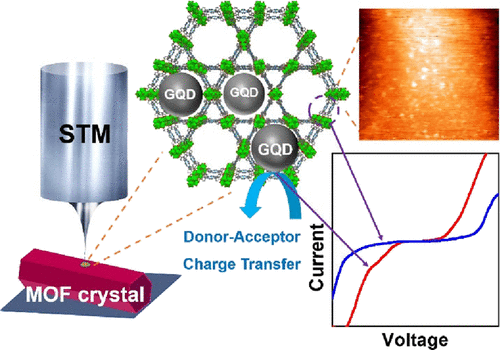当前位置:
X-MOL 学术
›
J. Phys. Chem. C
›
论文详情
Our official English website, www.x-mol.net, welcomes your feedback! (Note: you will need to create a separate account there.)
Probing Local Donor–Acceptor Charge Transfer in a Metal–Organic Framework Via a Scanning Tunneling Microscope
The Journal of Physical Chemistry C ( IF 3.7 ) Pub Date : 2020-09-08 , DOI: 10.1021/acs.jpcc.0c07477 Ting-Hsun Yang, Shao-Heng Yang, Yu-Chuan Chen, Darwin Kurniawan, Wei-Hung Chiang, Ya-Ping Chiu, Chung-Wei Kung
The Journal of Physical Chemistry C ( IF 3.7 ) Pub Date : 2020-09-08 , DOI: 10.1021/acs.jpcc.0c07477 Ting-Hsun Yang, Shao-Heng Yang, Yu-Chuan Chen, Darwin Kurniawan, Wei-Hung Chiang, Ya-Ping Chiu, Chung-Wei Kung

|
In an effort to gain more information beyond bulk conductivity of electrically conductive metal–organic frameworks (MOFs), herein, for the first time, we utilize a scanning tunneling microscope (STM) to probe local tunneling conductance in the atomic scale on the surface of conductive MOF-based crystals. By utilizing a porphyrinic zirconium-based MOF installed with electron-donating graphene quantum dots (GQDs) that was published in our recent study as a demonstration, significantly distinct electronic properties can be observed between the locations with and without the GQD–porphyrin donor–acceptor pairs. Such an STM technique is thus considered as a powerful tool to probe the spatial uniformity in electrical conductance and investigate the origins of conductivity for a range of conductive MOF-based materials.
中文翻译:

通过扫描隧道显微镜在金属有机框架中探测局部供体-受体电荷转移
为了获得除导电金属-有机骨架(MOF)的体积电导率以外的更多信息,在此,我们首次使用扫描隧道显微镜(STM)来探测原子表面上原子尺度的局部隧道电导。导电的基于MOF的晶体。通过使用我们最近的研究中发布的以卟啉为基础的锆基MOF以及电子给体石墨烯量子点(GQD),作为演示,在使用和不使用GQD-卟啉供体-受体的位置之间可以观察到明显不同的电子特性。对。因此,这种STM技术被认为是探测电导率空间均匀性并研究各种基于MOF的导电材料的电导率的有力工具。
更新日期:2020-10-02
中文翻译:

通过扫描隧道显微镜在金属有机框架中探测局部供体-受体电荷转移
为了获得除导电金属-有机骨架(MOF)的体积电导率以外的更多信息,在此,我们首次使用扫描隧道显微镜(STM)来探测原子表面上原子尺度的局部隧道电导。导电的基于MOF的晶体。通过使用我们最近的研究中发布的以卟啉为基础的锆基MOF以及电子给体石墨烯量子点(GQD),作为演示,在使用和不使用GQD-卟啉供体-受体的位置之间可以观察到明显不同的电子特性。对。因此,这种STM技术被认为是探测电导率空间均匀性并研究各种基于MOF的导电材料的电导率的有力工具。



























 京公网安备 11010802027423号
京公网安备 11010802027423号